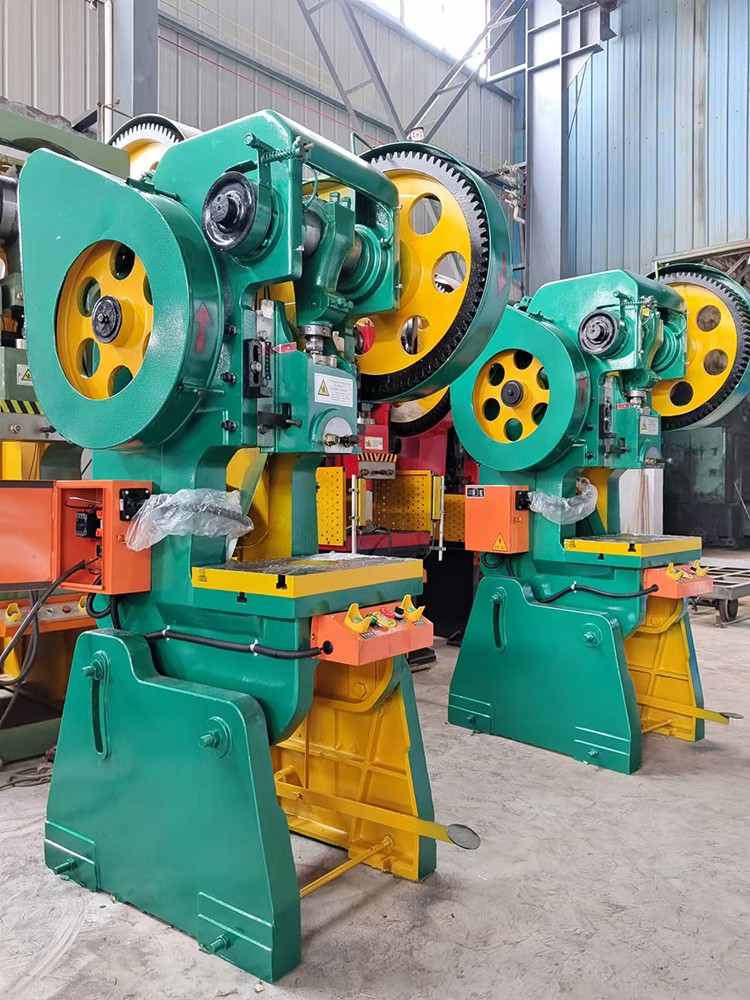We are a professional punching machine manufacturer with over 10 years of industry experience. Today, we would like to introduce you to the technical features of punching machines:

Punching machine is a kind of mechanical equipment that utilizes pressure to process metal or other materials, which is widely used in automobile manufacturing, electronic components, home appliance production and other industries. Its technical characteristics are mainly reflected in the structural design, power system, control mode and processing accuracy.
1, Structural design features
The core structure of the punch press includes the body, slide, table and transmission system. The machine body usually adopts integral casting or steel plate welding to ensure high rigidity and stability and reduce vibration during processing. The slide is the executing part of the stamping action, which realizes the up and down reciprocating motion through the crankshaft or hydraulic drive. The table of modern presses mostly adopts adjustable design to adapt to different sizes of molds and improve the versatility of the equipment.
Open body and closed body are two common structures. Open body is easy to operate and mold replacement, suitable for small and medium-sized workpiece processing; closed body is more rigid, suitable for large tonnage stamping, can withstand higher impact. In addition, some high-speed presses adopt gantry structure to further optimize the distribution of force and ensure the stability of long-time operation.
2, Power system characteristics
The power system of punching machine is mainly divided into mechanical and hydraulic two kinds. Mechanical punch press drives the flywheel through the motor, and uses the crank linkage mechanism to convert the rotary motion into linear motion, which has the characteristics of fast speed and high efficiency and is suitable for mass production. Hydraulic press relies on hydraulic cylinders to provide power, with a wide range of pressure adjustment, can realize stepless speed change, suitable for deep drawing, fine pressure and other complex processes.
In recent years, servo motor-driven presses are gradually popularized. Servo presses can precisely control the motion curve of the slider, reduce impact noise, and adjust the stamping speed and force according to different materials, which has advantages in energy saving and flexible production.
3, Control mode characteristics
Traditional punching machines are mostly controlled by mechanical or relay control, which is simple to operate but less flexible. Modern punching machines are generally equipped with CNC systems, which can realize automatic processing through programming, and can store a variety of process parameters to reduce manual adjustment time. Some high-end models also integrate touch screen interface to support graphical operation, making it easy for workers to quickly set up stamping strokes, speeds and times.
Safety control is an important part of press technology. Photoelectric protection devices, two-handed operation buttons and emergency stop systems are common safety measures that can effectively prevent injuries caused by operating errors. In addition, some presses are equipped with mold monitoring functions to detect abnormal vibration or deflection during the stamping process in real time, providing early warning of possible failures.
4, Processing accuracy characteristics
The processing accuracy of the press directly affects product quality. The main factors affecting the accuracy include the stability of the movement of the slider, the clearance of the mold and the rigidity of the equipment. High-performance presses usually use precision guide rails and ball screws to ensure the straightness of the slider's trajectory and reduce the wear caused by partial loads.
Closed two-or four-point pressure distribution design helps to evenly transmit the punching force to avoid workpiece distortion. Some precision presses are also equipped with a dynamic balancing system that counteracts the inertial force at high speeds to further enhance processing consistency. For products that require high precision, such as electronic connectors or miniature parts, the repeatability of the press needs to be controlled to the micron level.
5, Adaptability and expandability
Modern punching machine focuses on versatility and expandability. By replacing the mold, one machine can complete a variety of processes such as punching, cutting, bending, stretching and so on. Some models also support automation line, with robot or conveyor belt to achieve unmanned production. The modular design allows users to choose accessories such as feeders and scrap collection devices according to their needs, improving overall production efficiency.
The technological development of punching machines has always been centered on the three main goals of efficiency, precision and safety. From traditional mechanical drive to servo control, from single processing to flexible production, the innovation of punching machine in structure, power and control continues to promote the progress of manufacturing. In the future, with the popularization of intelligent and green manufacturing, punching machines will further improve energy efficiency and automation to meet more complex industrial needs.
If you are interested in punching machines, please contact us.
 Address:Room 1202, Detaitang Building, No. 118 Huaguang Road, Zhangdian District, Zibo, Shandong
Address:Room 1202, Detaitang Building, No. 118 Huaguang Road, Zhangdian District, Zibo, Shandong WhatsApp:+8615653328535
WhatsApp:+8615653328535 Wechat: +8615965331535
Wechat: +8615965331535  E-mail:zs@sdsmachinery.com
E-mail:zs@sdsmachinery.com